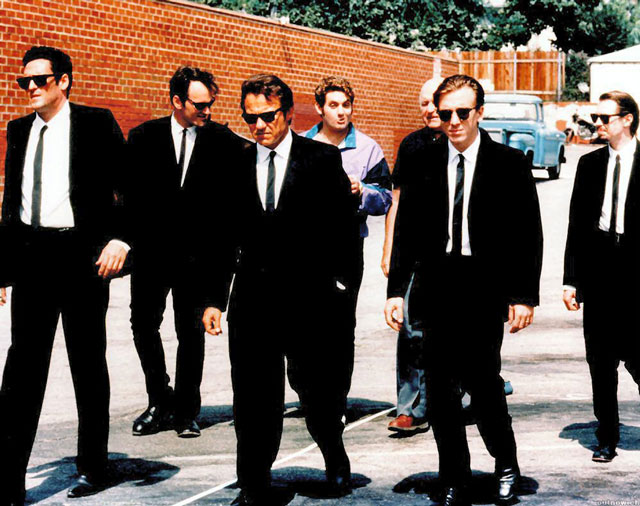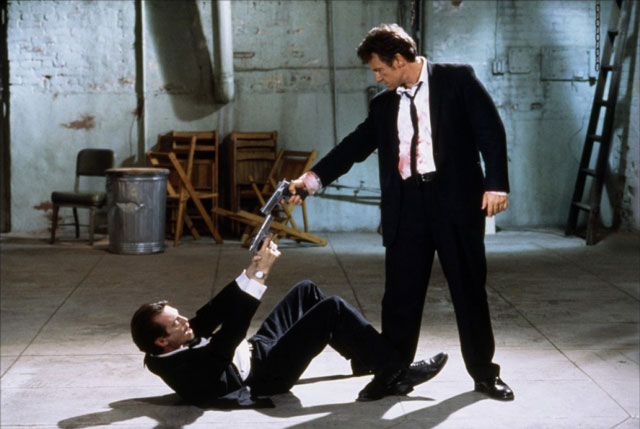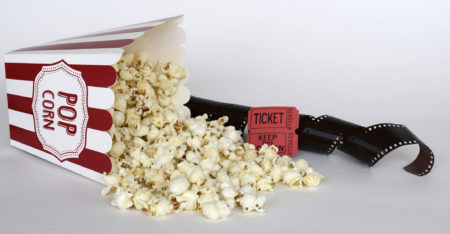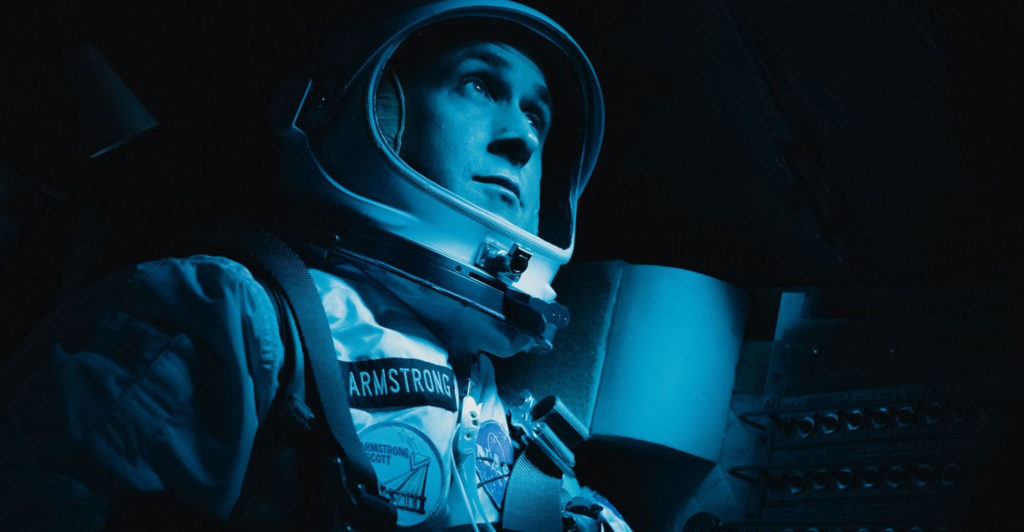Reservoir Dogs, released 20 years ago in the US this month, blindsided almost everyone who saw it when it first came out with its fragmented storytelling, its juxtaposition of jaunty pop music and bracing violence, and its rat-tat-tat dialogue. That it feels almost conventional today is just a reflection of how influential Quentin Tarantino’s debut would be for the next two decades.
Kinetic, politically incorrect, brutal and darkly funny — all gleefully so — Reservoir Dogs was a stark contrast to the right-on, inert and mannered fare favoured by the curators of Sundance, the film festival that was (and still is) the touchstone for American independent moviemaking.
Those that were not shocked by the film’s vulgarity and carnage when it was shown at Sundance in 1992 were invigorated by its inventiveness and playfulness. Though it lost the festival’s main prize to the charming In the Soup, Dogs was the most exciting thing to hit Sundance since Joel and Ethan Coen’s Blood Simple in 1985.
Dogs dropped the unsuspecting audience into the midst of a group of gangsters codenamed for colours, camera swirling between them as they sit in a diner discussing the meaning of Madonna’s Like a Virgin and the morality of tipping waitresses. In the next scene, Mr Orange (Tim Roth) is bleeding from a gut wound as Mr White (Harvey Keitel) rushes him to a rendezvous with the rest of the crew.
From there, things just get more screwed up as the film zigzags between past and present to show how the gang members are recruited for a diamond heist and what happens to each of them when it all goes wrong. The most talked-about part — a grinning Mr Blonde (Michael Madsen) jiving to Stealers Wheel’s Stuck in the Middle With You while carving off a cop’s ear with a straight razor — distilled the Tarantino aesthetic into a single scene.
“People seldom died in Sundance films, lest of Aids, old age or boredom, and in [Reservoir] Dogs, they not only died, they died slowly, painfully, bloodily with feeling,” writes Peter Biskind in Down and Dirty Pictures, his authoritative overview of the American independent cinema in the 1990s. And the film’s outspoken, enthusiastic director — a bit like Popeye on amphetamines — was born to be a star.
Asked to justify the violence, Tarantino goaded his critics: “I don’t know about you, but I love violent movies. What I find offensive is that Merchant-Ivory shit.” Welcome to what Biskind calls the new brutalism — at that time, a welcome counterpoint to the dull worthiness of the American independent scene.
Tarantino initially planned to fund the film from US$30 000 he raised from selling the script for True Romance, which was filmed by the late Tony Scott. When Keitel came on board as an actor and co-producer, Tarantino was able to boost his funding to a modest but more manageable $1,5m. What he made is a timeless class lesson in shoestring filmmaking.

The film made do with simple sets and props; the iconic black suits and skinny ties the gangsters wear were donated by a designer with a fondness for hardboiled movies. The production values did not matter because of the strength of Tarantino’s writing, his dialogue recalling the macho profanity of David Mamet (one critic called it “Glengarry Glen Ross with guns”) and the hardboiled patois of Elmore Leonard.
Reservoir Dogs is an art movie that is also a genre film — both a shrewd deconstruction and a reverent celebration of the heist movie. “Dogs is an anti-art film art film, a canny amalgam of outsider and insider art,” writes Biskind. “If the New Wave gallicised Hollywood B-movies, Tarantino re-Americanised the French hybrids, reclaiming them as it were.”
Reservoir Dogs had its antecedents — the pop-culture subversions of David Lynch; the inter-textual cinematic collages of the Coens; the way Bret Easton-Ellis sprinkled odes to Phil Collins between the graphic murders in his novel American Psycho — but it had an incomparable sheen of nouvelle vague cool.
Tarantino liked to say that he went to “films” rather than “film school”, devouring and ingesting everything on the shelves of the Los Angeles video store where he was a clerk. Where the New Hollywood directors like Martin Scorsese and Brian De Palma idolised Orson Welles and the French New Wave, Tarantino was a connoisseur of low culture.
For Tarantino, Bruce Lee’s Enter the Dragon was as worthy of adoration as Jean-Luc Godard’s Breathless. In addition to Hong Kong chop socky, grindhouse flicks and spaghetti Westerns, he also loved bubble-gum pop, comic books and hardboiled detective stories. With the eye of a magpie, Tarantino picked out the shiniest pieces in the trash to make his movies.
Reservoir Dogs was shameless in how it plundered other films for shots, motifs, characters and plot points: here a piece from The Killing, there a slice of Kansas City Confidential, perhaps slivers of The Asphalt Jungle and Ocean’s 11. The Taking of Pelham 1-2-3 gave Tarantino the idea to give his characters colour-coded names, while the 1980s Hong Kong crime epic City on Fire inspired the undercover cop and the bloody Mexican stand-off at the end of the film.
The way Tarantino assembled the component parts, however, was exhilarating and witty. Like the good poets in the TS Eliot essay that spawned the maxim “immature poets imitate; mature poets steal”, Tarantino welded his thefts into a new whole that was “unique, utterly different from that from which it was torn”. Like the bug-eyed Mr Pink (Steve Buscemi), Tarantino is the guy who hotfoots it with the diamonds. Unlike Mr Pink, Tarantino makes a clean getaway.

Unlike most heist films, Dogs shows little of the planning of the heist and nothing of the robbery itself. Dogs occupies the prosaic spaces between what most films call the action and the plot, finding humour and incident in the parts of the story that most films in the genre skip. Its characters, too, are unforgettable, and brought to vivid life by an ensemble cast.
Though Reservoir Dogs made a return on its modest budget, it wasn’t a smash hit at the time it was released. Most people would only see the film after Tarantino broke down the doors to the mainstream with Pulp Fiction in 1994. But its impact was immediate and disproportionate to its box-office take.
For starters, it gave Keitel’s career a turbo boost, allowing him at last to escape the shadow of Robert De Niro and Martin Scorsese. Keitel was the first but not the last fading star to get renewed shine from a Tarantino movie. Dogs also cemented the relationship between Bob and Harvey Weinstein and Tarantino.
The film didn’t much make much money for the Weinsteins’ Miramax — that would come later with Pulp Fiction — but it positioned Miramax as a distributor and boutique studio right on the cutting edge of the movie business. It’s with good reason that Miramax became known as the firm that Quentin built.
What really matters, though, is the film’s influence on other filmmakers. It was said of the Velvet Underground’s debut album that it only sold 1 000 copies, but each person who bought it formed a band. Within four years of the release of Dogs, it felt like everyone who had seen the film had made a movie.
There were some worthy heirs — like Bryan Singer’s The Usual Suspects and Guy Ritchie’s Lock, Stock and Two Smoking Barrels; a few competent ones — Things to Do in Denver When You’re Dead; and many awful copies — Two Days in the Valley, Truth or Consequence NM, Killing Zoe, Love & a .45. Today, it’s hard to find a crime or noir film that doesn’t feel at least a little influenced by Dogs.
Dogs stills stands up fairly well now, even if Tarantino quickly surpassed it with Pulp Fiction and Jackie Brown, and even if time has robbed it of its shock value. It is a little raw in places, but also smart and confident. The dialogue still crackles and burns, the film moves at a brisk pace, and the camerawork is clever without being showy.
Tarantino may occasionally mock his critics by proclaiming a philistine’s love for cinematic violence, but there’s a moral core and aesthetic sense to his films that subverts his claims of nihilism. Dogs is, at its heart, a lamentation for the loss of integrity, heroism, competence, honour among thieves. And it has a sense of humour that sets it apart from its nastier, shallower copies.
The violence, though shocking at the time, is not gratuitous in the same way as it is in many of the films that followed Dogs. Re-watching Dogs to write this article, I still winced during the ear slicing scene, but noticed that you don’t actually see the act. The camera discretely pans to a warehouse wall inscribed with the graffiti “Watch your head”.
The scene that sticks with me in the end is that of the fatherly Mr White cradling the dying Mr Orange, his face wracked with pain upon hearing that the kid he stuck his neck out for is an undercover cop. For a director who claims to disdain sentimentality, Tarantino sure has a sweet side. — (c) 2012 NewsCentral Media
- Read more: Close Read: “Reservoir Dogs”
- Read more: Where does the title “Reservoir Dogs” come from?




